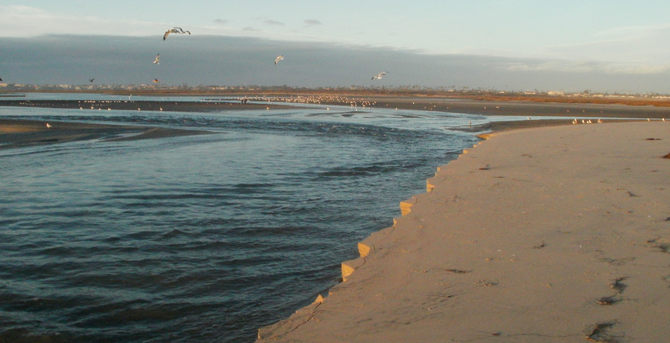 Facebook
Facebook
 X
X
 Instagram
Instagram
 TikTok
TikTok
 Youtube
Youtube

San Diego National Wildlife Refuge biologists are monitoring the movement of the 450,000 cubic yards sand dumped on Imperial Beach shores last fall, worried that southbound sand will block the river mouth as it did in 2010.
"If enough of this comes down here and settled or gets flushed into the river mouth, we've got a serious problem," U.S. Fish and Wildlife biologist Brian Collins said. "The estuary's ability to flush out with the tides is vital to the health of the estuary and all the threatened and endangered species that live here."
The sand sneaking into the estuary is the latest mess arising from the San Diego Association of Governments–financed "beach replenishment" project that dumped 450,000 cubic yards of sand on the beach near the pier in September and October. By December, the uneven dumping of sand left ponds next to buildings on Seacoast Drive, and residents found garages full of water trapped by the sand bars; those conditions left them worried about the buildings' elevator shafts and foundations.
Repeated rearrangement of the sand and trench-digging — bulldozers on the beach — have not solved the problems, residents say. The estuary's coast front starts south of the affected buildings.
So far, tides and swells have carried the sand 3800 feet — about 3/4 of a mile — south of the original dumping site, creeping toward the mouth of the largest and last undivided wetlands in Southern California. The estuary flushes twice a day with saltwater as the tide rises and drops, creating a unique salt marsh where a half dozen endangered or threatened species of birds make their homes. If the river mouth is blocked, the salt marsh begins to die.
Collins and other estuary staff check the beach north of the river regularly and say the difference between native sand and imported sand is pretty clear.
"The new sand is very coarse and absorbs water," Collins said. "It poses a special hazard to the estuary."
A similar sand-replenishment project in 2010 left the estuary with no choice but to dredge the river mouth at a cost of about $15,000. The project required the involvement of more than a half dozen agencies; bulldozers worked for two days to reopen the tidal channel.
"The moral of the story is 450,000 cubic yards [of sand] may be too much at one time," Collins said.


San Diego National Wildlife Refuge biologists are monitoring the movement of the 450,000 cubic yards sand dumped on Imperial Beach shores last fall, worried that southbound sand will block the river mouth as it did in 2010.
"If enough of this comes down here and settled or gets flushed into the river mouth, we've got a serious problem," U.S. Fish and Wildlife biologist Brian Collins said. "The estuary's ability to flush out with the tides is vital to the health of the estuary and all the threatened and endangered species that live here."
The sand sneaking into the estuary is the latest mess arising from the San Diego Association of Governments–financed "beach replenishment" project that dumped 450,000 cubic yards of sand on the beach near the pier in September and October. By December, the uneven dumping of sand left ponds next to buildings on Seacoast Drive, and residents found garages full of water trapped by the sand bars; those conditions left them worried about the buildings' elevator shafts and foundations.
Repeated rearrangement of the sand and trench-digging — bulldozers on the beach — have not solved the problems, residents say. The estuary's coast front starts south of the affected buildings.
So far, tides and swells have carried the sand 3800 feet — about 3/4 of a mile — south of the original dumping site, creeping toward the mouth of the largest and last undivided wetlands in Southern California. The estuary flushes twice a day with saltwater as the tide rises and drops, creating a unique salt marsh where a half dozen endangered or threatened species of birds make their homes. If the river mouth is blocked, the salt marsh begins to die.
Collins and other estuary staff check the beach north of the river regularly and say the difference between native sand and imported sand is pretty clear.
"The new sand is very coarse and absorbs water," Collins said. "It poses a special hazard to the estuary."
A similar sand-replenishment project in 2010 left the estuary with no choice but to dredge the river mouth at a cost of about $15,000. The project required the involvement of more than a half dozen agencies; bulldozers worked for two days to reopen the tidal channel.
"The moral of the story is 450,000 cubic yards [of sand] may be too much at one time," Collins said.
Comments